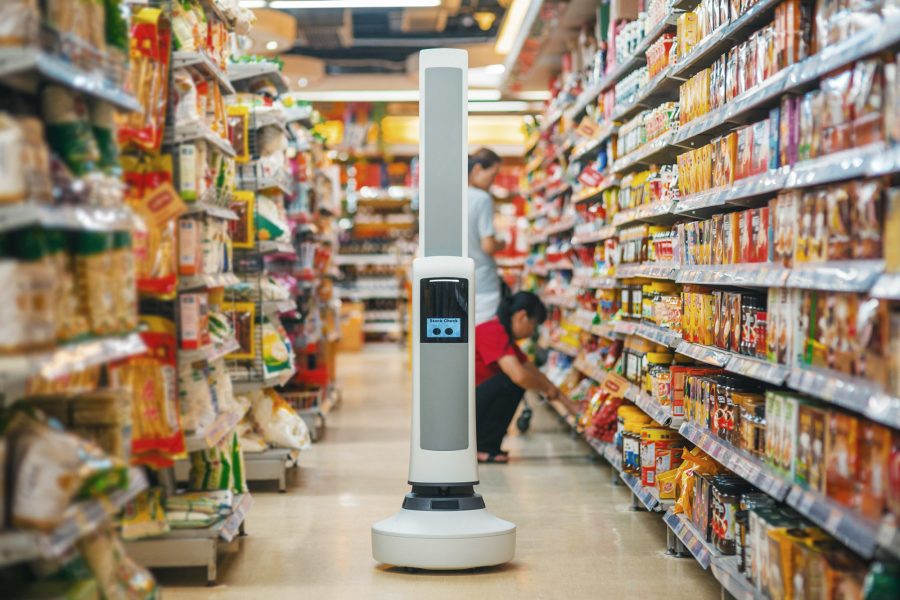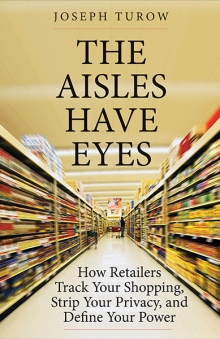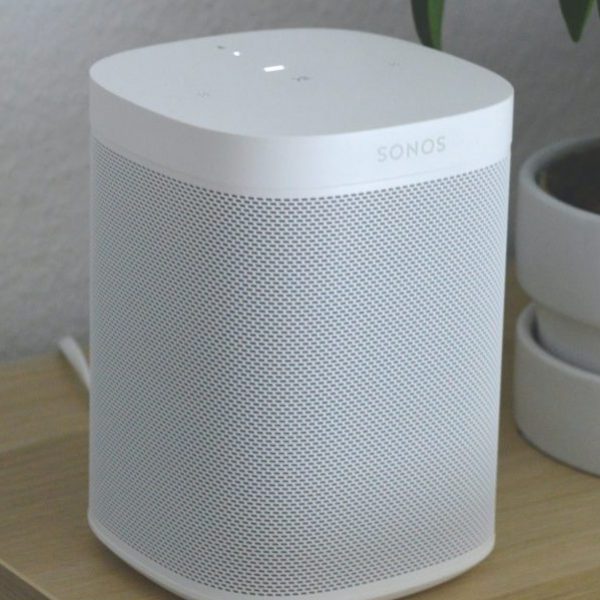Hunting Mobile Shoppers
Joseph Turow—
“Bricks and mortar is dead; long live bricks and mortar!” This was the surprising theme that emerged from the sprawling 2014 Internet Retailer Conference and Exhibition, reported Laura Heller, editor in chief of the online trade magazine FierceRetail. Everybody in retail had previously been emphasizing only the tremendous advantage that digital retailers had over physical stores because of the vast amounts of customer information they could amass and exploit. True, brick-and-mortar stores also could size up customers by recording their purchase history and by purchasing additional information about them from data brokers. But digital sellers could do the same—and a whole lot more. They could follow customers around the internet and track them at any site where they had shopped, and they could also present them with ads on other sites for the same items the shoppers had viewed earlier on the merchants’ site. When those shoppers returned to the sellers’ website the merchant could offer up the products they had previously considered and possibly rejigger the deal—change the price, add other items, reconfigure the warranty, and more—based on the shopper’s assessed value to the business, such as whether the person was a consistent customer yielding good margins for the store, a bargain hunter, or someone in between.
Given the seemingly insurmountable edge enjoyed by online retailers—beyond their extraordinary and ever-growing data-base of information on individual shoppers, they also enjoyed virtually unlimited shelf space—some wondered whether physical retail real estate was dead weight, a hindrance to merchants attempting to compete with seemingly ever-flexible digital companies. But Heller noted that the zeitgeist was beginning to change. The attendees at the internet retailer conference, she said, were recognizing the physical store as “increasingly a critical part of an online or omnichannel strategy” (omnichannel is an industry buzzword that refers to the multi-faceted means by which a physical retailer can profitably meld its online and mobile phone capabilities with its physical resources).
The largest department stores, supermarkets, and discounters were well aware that online-only stores were continuing to move in on their turf. The success of Amazon was probably the biggest factor behind physical merchants’ new focus on beating internet rivals at their own game. Succeeding at this gambit was not going to be easy, however. At the end of 2014, Amazon announced that more than ten times as many items were ordered with same-day delivery for Christmas than in the previous year. Moreover, the company reported that nearly 60 percent of its customers had purchased from Amazon using a mobile device and that the percentage of people using mobile shopping increased as Christmas drew closer. Total U.S. holiday sales from the Amazon app doubled in 2014.
Major physical retailers understood that developing winning websites and apps was necessary to countering this challenge, but they saw it as just one part of a larger overall strategy. Believing that a material store in one form or another would always be a key to success, retailing executives wanted to encourage shoppers to buy items from their websites or apps and then pick them up from their brick-and-mortar stores. More important, they decided to copy what internet retailers had been doing: tracking shoppers to discern their lifestyles and the goods that appeal to them; distinguishing individual shopper value based on that information and the shopper’s prior purchases; and (depending on a shopper’s assessed value) offering targeted enticements, which could include altered pricing, to encourage both a relationship and a sale.
As late as 2013, many brick-and-mortar chains continued to back away from direct confrontation with internet-only companies. Executives, especially those overseeing major department-store and discount operations, instead tried to work around online sellers by offering merchandise that their shoppers would not be able to find anywhere else. For example, they increased their stock of exclusive brands or had their suppliers tweak the products they produced for them just enough so the items would be assigned new barcodes.
After 2013, these companies shifted their focus and began to build parts of the business they felt could beat or at least match online-only merchants. For one thing, they designated part of the physical store as a warehouse. The idea was not new; during the 1990s and early 2000s Walmart, Sears, and Macy’s were among retailers that had instituted systems enabling shoppers to buy online and pick up at a nearby chain location. They called the practice “shop online and ship to store,” or “click and collect.” But many other merchants demurred. The chief executive of supermarket giant Kroger told investors as late as October 2013 that people went online for recipes and coupons and to check their loyalty reward points, but “not for e-commerce.” The international retailer Ahold, whose U.S. chains include Stop & Shop and Giant-Landover, had a different view: it had already instituted its Peapod service, which enabled customers in select areas to order online and pick up the goods at one of its nearby supermarkets. Nevertheless, as far as Kroger was concerned, “E-commerce makes up a tiny, tiny percentage of the food business.”
By 2015, though, the online purchasing and in-store pickup system was becoming commonplace for most sellers with a national footprint. Even Kroger was now moving in that direction with an experiment in Houston. Department stores and large discount chains were also touting their ability to accept returns from internet purchases at the physical store. Astonishingly, in 2013 customers returned an estimated third of all purchases they made on the internet, and this proved to be an opportunity for physical stores to shine: surveys indicated that customers liked the choice of returning goods to any branch, regardless of where they had made the purchase.
With these new developments physical retailers started going head to head against their biggest internet-only competitors, who wanted to make brick-and-mortar stores look anachronistic. Amazon, eBay, and Google Express delivery service instituted a new arrangement by which they contracted space in shopping centers, stores, and bus stations for pickups and returns, but the program did not initially catch on with shoppers. Instead, a number of online-only businesses—grocery delivery service Instacart, Google Express, and eBay, among others—focused on beating brick-and-mortar’s alleged location advantage by targeting delivery to home or office. They aimed to make their services so convenient that shoppers would not even have to go to a physical store to purchase the most basic goods.
Amazon was at the forefront of such efforts. In 2013 the company announced a plan to use drone aircraft to deliver packages to customers’ porches, lawns, or roofs within thirty minutes of an order being placed. Although the U.S. Federal Aviation Administration initially balked at the notion of drones flying around with parcels, it eventually allowed these and other unmanned initiatives in airspace below four hundred feet. In a more conventional move, the company began offering free two-day shipping in 2005 on over twenty million items via its Amazon Prime program (memberships cost $99 a year in 2015). In 2009 it began offering same-day delivery in Manhattan, Philadelphia, San Francisco, and a few other heavily populated areas. And for the 2014 Christmas holiday season the company offered free two-hour and $7.99 one-hour delivery service in Manhattan for one day between the hours of 6 a.m. and midnight. Twenty-five thousand products were eligible for this service, including paper towels, shampoo, books, toys, batteries, USB cables, and Kindle Fire tablets. Bike messengers made many of the deliveries. Amazon planned to expand the offering to other large metropolitan areas. By offering same-day delivery the company was hoping its customers would decide to “skip the trip to a retail store,” an executive at a mobile apps production firm told Mobile Commerce Daily. Dave Clark, Amazon’s senior vice president of worldwide operations, confirmed this goal: “There are times when you can’t make it to the store and other times when you simply don’t want to go. There are so many reasons to skip the trip and now Prime members in Manhattan can get the items they need delivered in an hour or less.”
The brick-and-mortar side fought back. Walmart, Macy’s, hhgregg, and others moved to match the quick-delivery programs offered by Amazon (and others). Mall operators such as Simon and Westfield also stepped in to help their smaller tenants compete. The move to quick delivery involved the implementation of new processes and technologies on a local level, and it also meant that part of the store had to be turned into a kind of mini-warehouse. By 2015 stores were still mostly testing their programs in small patches of the country, but the two sides seemed to achieve a rough parity in the ability to, literally, deliver the goods. Analysts noted that while these efforts were expensive and might not even distinguish any one retailer over another, same-day delivery by physical retailers was probably necessary. “Like other traditional brick-and-mortar retailers, Macy’s is adapting to a digital age in which people are growing accustomed to getting what they want when they want it,” reported CBS’s “MoneyWatch.” “The chain probably has little choice but to face this new reality and take a risk on same-day delivery.” An executive at the grocery consultancy Willard Bishop noted the same situation with supermarkets. “It’s messy, but it’s inevitable,” he said in 2016. “Stores that do it well are reporting incremental gains of up to 30 percent when shoppers use them for both physical and online shopping. But it’s still not profitable.”
As the battle continued to rage, both sides ignored a crucial terrain: the selling floor. It was there, amid store aisles, that about 90 percent of all retail goods continued to be bought and sold as of May 2015, according to the U.S. Census Bureau.And just as some brick-and-mortar retailers nervously turned part of their stores into warehouses for the internet world, they viewed their aisles equally apprehensively as domains that, they felt, would also have to function somehow like the internet. Although the notion that a store aisle could serve in such a capacity might seem odd, merchants had concluded that this would be the new role of the physical store in the digital shopping era. “Savvy retailers are using multimedia content to make the shopping experience more engaging,” wrote Justin Honaman, a partner in a company that provides customer analysis technologies, in January 2014. “They will offer in-store only events and services . . . aimed at bringing customers to stores and keeping them there.”He also predicted that personalization “lies at the center of omnichannel marketing strategies in 2014,” pointing out that retailers now had the means to “reach shoppers with what they want, when they want it and via the channel they prefer to shop. Retailers will also work to curate the right product information at the right time in the shopping process.”
To achieve these goals, he wrote, retailers will need to “connect the dots . . . and [create] a comprehensive customer profile.” According to Honaman, retailers with physical stores actually had a unique advantage over their internet-only competitors. While each group could compile mountains of data and build individual profiles by tracking shopper behaviors and purchases online, and then target personalized ads and discounts, only physical retailers could exploit this gold mine of customer knowledge and engagement when customers went from the virtual to the material world, as they so often do. He argued that brick-and-mortar emporia had to be seen as an integral part of a new retailing mandate to “reach shoppers with what they want, when they want it, and via the channel they prefer to shop.” For example, a physical retailer could offer an individual the most effective prices “both in-store and online,” and in a real-time, personalized manner.
In Honaman’s view the key to success was the cellular phone. “Consumers are increasingly using mobile phones and tablets for product research and online purchase,” he wrote. “The combination of portability, connectivity and relative affordability gives the smartphone a privileged place in driving always-on commerce.” Indeed, the smartphone was already becoming part of retailing strategy. “Mobile is the new first screen,” noted a MediaPost article at the end of 2014. “On average, people check their phones 150 times per day. More than one third of customers are ‘mobile only.’ With stats like this coming out daily, we (should all) get it.” That meant, the writer said, developing mobile strategies for engaging with the shopper for “loyalty and revenue.”
From The Aisles Have Eyes: How Retailers Track Your Shopping, Strip Your Privacy, and Define Your Power by Joseph Turow, published by Yale University Press in 2018. Reproduced with permission.
Joseph Turow is Robert Lewis Shayon Professor of Communication and associate dean for graduate studies at the Annenberg School for Communication at the University of Pennsylvania and the author of several books, including Media Today: Mass Communication in a Converging World and The Daily You: How the New Advertising Industry Is Defining Your Identity and Your Worth.
Further Reading



























